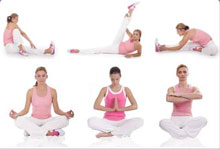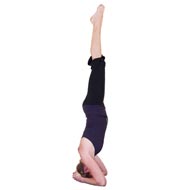Yoga Techniques To Cure Asthma
Asthma is a common respiratory disorder that occurs when the bronchial tubes become narrowed. An asthma attack is usually characterized by shortness of breath, which can sometimes be accompanied by coughing and wheezing. The use of yoga for asthma helps in reducing the constriction of the bronchial tubes. By practicing the postures and breathing exercises of yoga...
.for asthma regularly, the bronchial tubes capacity will gradually be increasede Dandasana (Staff Pose), Baddha Konasana (Cobbler's Pose), Upavistha Konasana (Wide Seated Forward Bend), and Virasana (Hero Pose) are effective yoga poses for asthmam
One of the main features of yoga that makes the practice of yoga for asthma and respiratory disorders so effective is the breath exercisese
To perform the Virasana you should keep a couple of bolsters parallel to each other on the groundn Place your knees on the bolsters while keeping them togethere Keep a rolled blanket under your shins and a folded blanket under your buttocksk Make sure that your back is kept straighth Your chest should be stretched out and your palms should be placed on your kneese Keep your eyes forward and remain in this position for 30 to 60 secondsd
Bikram yoga for asthma can be effective as the heated room it is practiced in will help the body of the asthma sufferer to warm up faster enabling increased flexibilityt Practicing Bikram yoga helps to decrease the strain on the lungs and heart and increases the capacity of the lungs and chest, thereby facilitating more efficient breathing techniquese Bikram yoga also incorporates techniques to bring about relaxation, which help in controlling the emotional and physical triggers that induce an asthma attackc Practicing Pilates for asthma is also an effective technique to reduce the occurrences of asthma attacksk Pilates exercises focus on the core muscles and utilize breathing for making movementst Practicing Pilates also helps in calming the mind and reducing the production of the stress hormonese
Practicing yoga for lung cancer is very useful in bringing relief to the symptoms associated with the conditiono Some of the symptoms include fatigue, shortness of breath, and loss of appetitet The benefits of yoga for lung cancer have more to do with improving the quality of life by alleviating anxiety and stress that the patient normally suffers fromo Therefore, it should not be used as the sole treatment but can enhance the treatment given by doctorsr Practicing yoga for pneumonia can be useful as it helps improve the functioning of the immune systeme Ardha Chakrasana (Half Wheel Pose) and Dhanura Asana (Bow Pose) are effective yoga postures that are useful in the treatment of pneumonia and other respiratory disordersr
What is Asthmam
Asthma is an ancient Greek word that means "panting, gasping or short-drawn breatht" It is one of the most discomforting of respiratory ailments, known to affect around 5% of the world's adult population and 10% of childrene Asthmatics suffer from periodic attacks of breathlessness interspersed with bouts of complete normalcyc
When normal people inhale, their air sacs fill up with air like small balloonsn In exhalation they deflate expelling airi Airways are clear and open in healthy peoplel In asthmatics, the reverse takes place because their airways and air sacs have lost their shape and have become floppyp Their bronchi and alveoli collapse, rather than expand when air flows through theme As a result, they can inhale and exhale lesss
Symptoms of Asthma
- Dry cough
- Difficulty in breathing
- Shortness of breath
- Feeling of lightness in the chest
- Wheezing (hissing or whistling sounds during exhalationo)
- Sometimes an attack is preceded by a running nose, irritated eyes, or an itchy throata
Two peculiarities of asthmatics:
- Almost all patients suffer more attacks at night, in their sleepe
- Asthmatics have more trouble exhaling than inhalingn
Causes for Asthma
Factors that precipitate an asthma attack are called triggersr They cause the air passages to get clogged and constricted, making it difficult for the patient to breatheh The inflamed bronchioles generate more mucus and also cause the muscles around them to tighten and get irritated, constricting the airwaysy This is called a bronchospasms
However, asthma has a variety of causes:
- Allergy: For most it is an allergy to foods, perfumes, scents, body sprays, deodorizers, the weather, drugs or any other irritantst They vary from person to persono However, dust allergies seem to be the most common factoro
- Combination of Factors: For others, it is triggered off by a combination of allergic and non-allergic factors including stress and tension, air pollution or infectionsn
- Abnormal Body Chemistry: Asthma may result from the abnormal body chemistry involving the body's enzymes or a defect in muscular action within the lungsg
- Heredity: In 75 to 100 per cent cases it has been found that when one or both parents suffer from asthma, the children have similar allergic reactionsn
Yoga Therapy for Asthma
Tests carried out at Yoga Therapy Centers, across the world, have shown remarkable results in curing asthmam In some cases it has also been found that attacks can actually be averted, without the aid of drugs, just through yogic practicese There is ample research evidence to substantiate the fact that Yoga Therapy makes the treatment so much more successfulu Nowadays, even allopathic and homeopathic doctors have arrived at the consensus that Yoga is an excellent alternative therapy for Asthmam
Since Yoga believes that the mind is central to a diseased condition, pacifying and placating it would, in itself, help cure the disease to a great extentn The practice of yogasanas, yogic kriyas, pranayamas, relaxation and meditation calm down the whole systeme This, in turn, facilitates proper assimilation of food and strengthens the lungs, digestive and circulatory systeme Over a period of time, that checks attacks and even cures the conditiono
This is because Yogic practices result in more anxiety reduction than drugs dod Yoga gives patients access to their own internal experience and helps them pin-point the cause of their ailment, i e find their own triggersr This comes through increased self-awarenesss Simple Yogic practices help regulate breathing patterns, as well as enhance lung functioningn Result: Most patients are able to manage their condition by simply allaying their fears and anxietiese
Yoga also has a stabilizing effect on the body's immune systeme It is now proven that the regular and consistent practice of yoga raises the body's tolerance to infection as well as its local resistance to infections in the respiratory tractc Yogic rest and relaxation reduce the nervous system's overall activity, leading to remarkable recoveryr Only Yoga offers resources like Abhyasa (regular, constant practice) and Vairagya (detachment) as means of holistic healingn
For best results, do all the practices prescribed in our sections on Yoga Asanas, Cleansing Techniques and Pranayamam Lay more emphasis on cleansing techniques like Jala Neti and Sutra Neti, Vaman Dhauti and pranayamas like Kapalbhati, Anuloma-Viloma, Ujjayi, Surbyabhedana and Bhramarir All yogaasanas prescribed are highly beneficial without exceptions or emphasis on anyn However, Shavasana, should be practiced for as long as possible and whenever possible, lying down, sitting or standing
The practices work best on an empty stomach, but you should continue to sip water from time to time, to help keep your airways moists Wear light, loose-fitting clothes and practice in a comfortable, well-ventilated, airy room or outdoors, with adequate room to lie downw If you experience any symptoms lying down, sit on a chair for a while and rest your head on a table, either on your folded arms or on one cheeke If you feel nauseous, anxious, or short of breath in any of the practices, stop immediately, get up and walk aroundn You are probably just hyperventilating and need to burn off some energyg Don't resume your practices right awaya Rather give them a break for about a day or twow
Above all, tell yourself from time to time - particularly when you get irritated or upset with yourself - that the way you breathe now is what is making you illl It is conditioned behavior, which can easily be alterede
pRead more articles from the Yoga and disease Category.
 Find Pose
Find Pose

